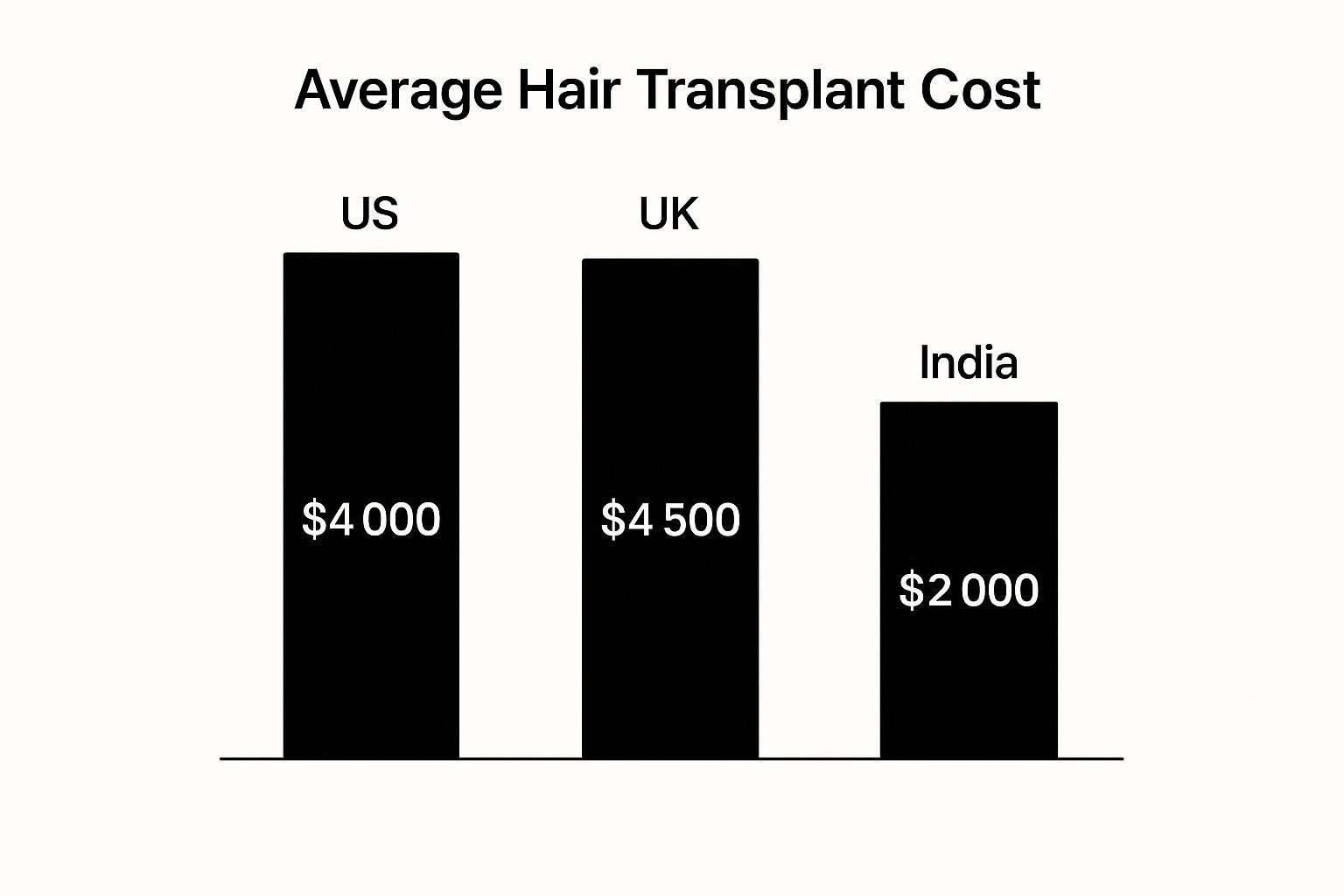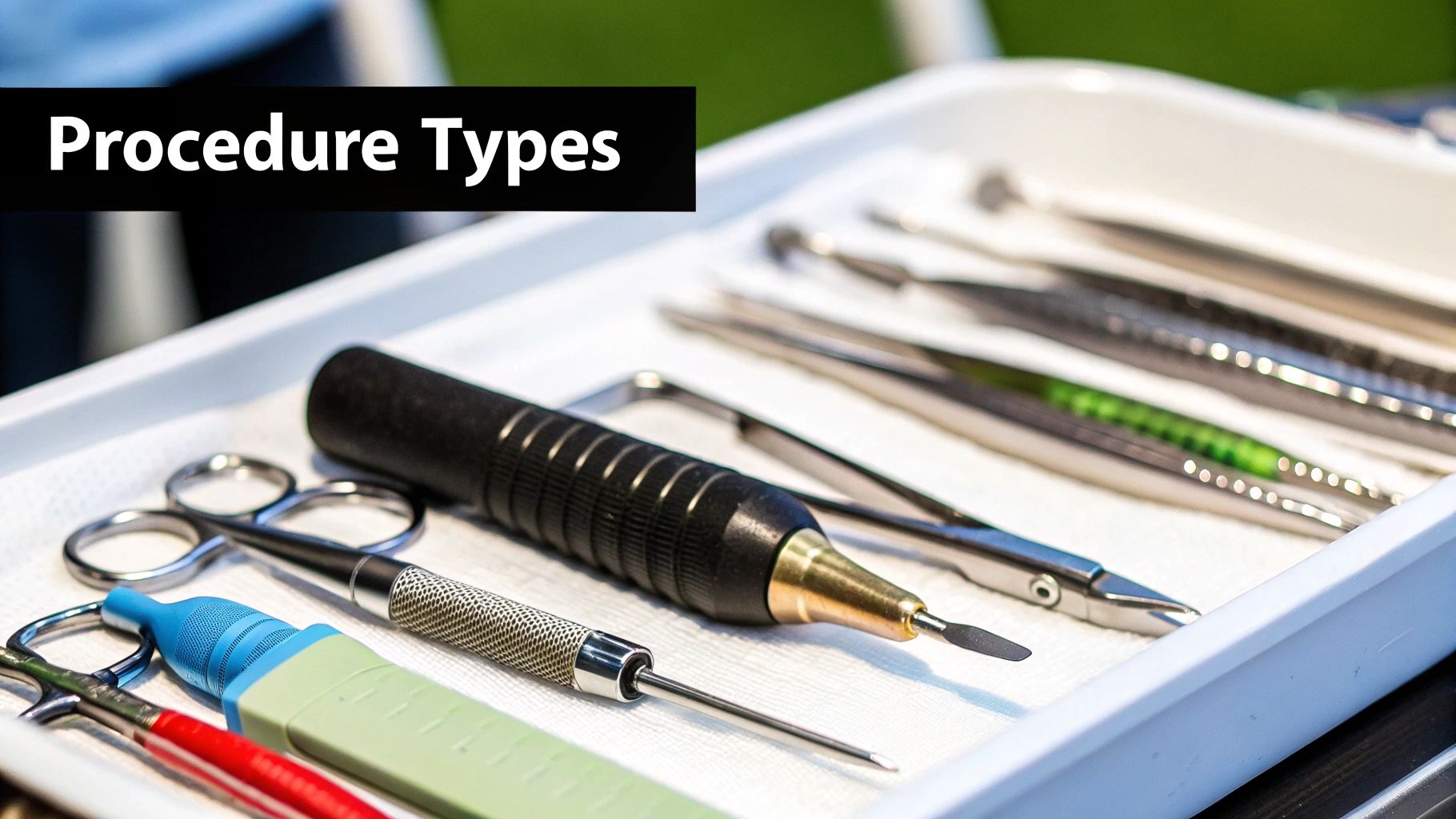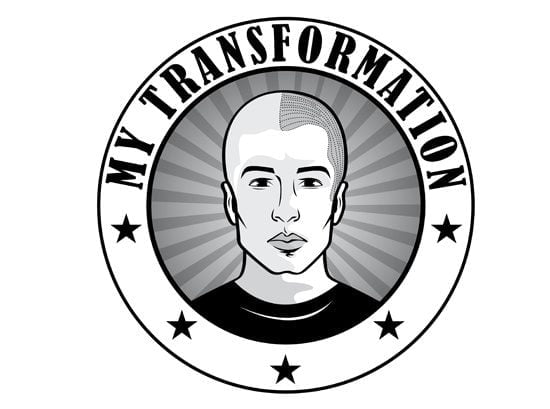
How Much Does a Hair Transplant Cost? Find Out Now
Share
Right, let's talk numbers. The first thing everyone wants to know is, "how much will this cost me?" The honest answer is that it really depends. You could be looking at anywhere from $5,000 for a small touch-up to over $18,000 for a more significant restoration.
It’s a bit like getting a quote from a builder. The final price tag is tied directly to the size and scope of the job.
Your Guide to Hair Transplant Costs in Australia
When we break down the cost, it all comes down to one thing: the number of hair grafts you need.
So, what's a graft? Think of it as a tiny, individual package containing one or more hair follicles. A surgeon carefully moves these grafts from a dense area of your scalp (usually the back) to the thinning spots. The total number of these grafts is what really drives the final cost. A small session to fill in a receding hairline is going to be far less expensive than a larger procedure to restore coverage across the crown.
Based on what we see in Australian clinics, there's a pretty clear pattern. Smaller sessions using common methods like FUE or FUT might start around $5,000 for up to 600 grafts. On the other hand, major restorations needing over 3,000 grafts can easily push past the $18,000 mark.
Key Takeaway: The single biggest factor determining your hair transplant cost is the total number of grafts needed to achieve the look you're after.
To help you get a better handle on what this might mean for your budget, we've put together a typical cost breakdown. Remember, these are just estimates. Your final quote will vary based on the clinic you choose and the specific technique they recommend. For a more detailed look at what goes into these figures, you can read this complete guide on hair transplant cost.
Estimated Hair Transplant Cost in Australia by Grafts
This table gives you a rough idea of what to expect for hair transplant procedures in Australia, broken down by the number of grafts.
| Session Size | Number of Grafts | Estimated Cost Range (AUD) |
|---|---|---|
| Small | 500 - 800 | $5,000 - $8,000 |
| Medium | 1,000 - 2,000 | $9,000 - $13,000 |
| Large | 2,000 - 3,000 | $12,000 - $16,000 |
| Extra Large | 3,000+ | $15,000 - $20,000+ |
As you can see, the price scales directly with the number of grafts. Your surgeon will determine the exact number you need during your consultation, which is the only way to get a firm, personalised quote.
Decoding the Key Factors in Your Final Quote
 So, what's the deal when one person gets a quote for $8,000 and another is looking at $15,000 for what seems like the same level of hair loss? The final number on your quote is a blend of several crucial factors, and it goes far beyond just counting grafts. Getting your head around these variables helps you understand exactly what you're paying for.
So, what's the deal when one person gets a quote for $8,000 and another is looking at $15,000 for what seems like the same level of hair loss? The final number on your quote is a blend of several crucial factors, and it goes far beyond just counting grafts. Getting your head around these variables helps you understand exactly what you're paying for.
After the number of grafts, the biggest influence on your final cost is the surgical technique the clinic uses. It’s a bit like comparing a hand-stitched leather bag to one that’s mass-produced; the more intricate, hands-on method will always have a higher price tag. This is a vital point to remember when you're weighing up quotes from different clinics.
FUE vs FUT: The Price Difference
The two main players in the hair restoration game are Follicular Unit Extraction (FUE) and Follicular Unit Transplantation (FUT). Each has its own process, and that directly impacts the cost.
-
Follicular Unit Transplantation (FUT): You might hear this called the "strip method." It works by removing a thin strip of hair-bearing skin from the donor area. Technicians then carefully dissect this strip under microscopes to get the individual follicular units ready for implantation. For the surgical team, it's a relatively quicker way to harvest a large number of grafts.
-
Follicular Unit Extraction (FUE): With FUE, the approach is much more meticulous. The surgeon extracts each follicular unit one by one, directly from the scalp. There’s no linear scar, just tiny, dot-like marks that are easily hidden.
Because FUE requires the surgeon to spend significantly more time and exercise incredible precision to harvest every single graft individually, it's almost always the more expensive of the two. You're paying for that intensive labour and the high level of skill needed to do it right.
The Surgeon and Clinic's Reputation
The experience of your surgeon and the standing of their clinic are huge factors in the final cost. A surgeon with years of experience, a gallery of fantastic results, and a top-tier reputation is going to charge more. It makes sense. You’re not just paying for the procedure; you’re paying for their expertise, their artistic ability, and the peace of mind that comes with a lower risk of complications.
It’s like hiring any expert at the top of their field. You expect to pay a premium for a proven track record of excellence. When it comes to cosmetic surgery, this really isn't the place to be bargain hunting.
A clinic's reputation is built on years of consistent results, prioritising patient safety, and maintaining the highest standards of care. That established trust is factored into the price, giving you a much higher chance of a successful, satisfying outcome.
Technology and Equipment
Top clinics are constantly investing in the latest technology to make the hair transplant process more precise and effective. This could mean anything from advanced imaging software for planning the procedure, robotic assistance for FUE, or specialised implantation tools that give the surgeon total control over the angle, depth, and density of the new hair.
This cutting-edge equipment doesn't come cheap, and the cost of purchasing and maintaining it is naturally reflected in the patient's bill. However, that investment often translates into better graft survival rates, more natural-looking results, and even a smoother recovery. You’re essentially making a trade-off: a higher initial cost for a potentially superior long-term result.
And for those exploring non-surgical avenues, it's also worth understanding the cost of scalp micropigmentation, which is another popular solution for hair loss.
Comparing FUE and FUT Procedure Costs
When you start looking at quotes for a hair transplant, one of the biggest forks in the road you'll encounter is the choice between FUE (Follicular Unit Extraction) and FUT (Follicular Unit Transplantation). This decision will have a huge impact on the final price tag. While both procedures get you to the same destination—a fuller head of hair—the way they get there is completely different, and that's reflected in the cost.
Think of it like getting a custom-tailored suit versus buying one off the rack. One requires far more intricate, hands-on work.
The FUT method, often called the "strip" technique, is the more traditional approach. It involves a surgeon removing a thin strip of skin from the donor area, usually at the back of your head where hair is most dense. This strip, packed with healthy hair follicles, is then passed to a team of technicians who meticulously separate it into individual grafts under powerful microscopes.
Because a large number of grafts can be harvested all at once, FUT is generally a quicker and more cost-effective procedure on a per-graft basis. This makes it a solid option for people needing extensive coverage who are also mindful of their budget.
Why FUE Is Priced at a Premium
Follicular Unit Extraction (FUE) is a more modern, less invasive technique. Instead of taking a strip of skin, the surgeon extracts each individual follicular unit, one by one, directly from your scalp using a tiny, specialised punch tool. As you can imagine, this process is incredibly detailed and time-consuming. It demands a massive amount of skill, precision, and patience from the surgeon.
The higher price of FUE is a direct reflection of this labour-intensive work. You're paying for the surgeon's expertise, the hours they spend hunched over, and the advanced technology required to do it right.
For many, though, the extra cost is a worthwhile investment.
The biggest drawcard for FUE is that it doesn't leave a linear scar. This is a game-changer for anyone who likes to wear their hair short. The recovery is also typically quicker and more comfortable than with FUT.
This chart gives you a bird's-eye view of how hair transplant costs can vary dramatically around the world, showing how local economic factors play a huge role alongside the procedure itself.

As you can see, procedures in Western countries like the US, UK, and Australia come with a higher price tag compared to places like India. This isn't surprising when you factor in the higher costs for skilled labour and clinical overheads in these regions.
And if scarring from either procedure is a concern, remember that there are fantastic ways to deal with it. Many people now look into scalp micropigmentation for hair transplant scars to expertly camouflage any tell-tale signs of surgery.
FUE vs FUT Head-to-Head Comparison
To really get a handle on which procedure might be right for you, it helps to see them compared side-by-side. Here’s a straightforward breakdown of the key differences between FUE and FUT.
| Feature | FUE (Follicular Unit Extraction) | FUT (Follicular Unit Transplantation) |
|---|---|---|
| Cost | Generally more expensive. The price reflects the meticulous, labour-intensive process of extracting each graft individually. | Typically more affordable, especially for large sessions, because harvesting grafts from a strip is much faster. |
| Scarring | Leaves behind tiny, dot-like scars scattered across the donor area. These are usually unnoticeable, even with short hair. | Results in a single, fine linear scar in the donor area. This is easily hidden by hair that's an inch or longer. |
| Recovery | Faster and more comfortable recovery. Most people can get back to their normal routine within a few days. | A longer recovery is needed. Stitches are usually removed after 10-14 days, and you'll have more restrictions on activity. |
| Ideal Candidate | Perfect for those who want to wear their hair very short, need smaller sessions, or prefer a less invasive option. | A great choice for patients who need a large number of grafts in one go and don't mind wearing their hair a bit longer to cover the scar. |
At the end of the day, the "best" procedure is the one that aligns with your specific pattern of hair loss, your budget, your lifestyle, and how you want to style your hair down the track.
How Costs Vary Across Australian Cities

When you start pricing up a hair transplant, you'll quickly realise that your postcode plays a surprisingly big part in the final quote. The cost of the exact same procedure can vary significantly between a major hub like Sydney and a smaller capital city. It’s not arbitrary—this price difference comes down to the clinic's own running costs.
Think of it like buying a coffee. A flat white in a bustling CBD will always cost more than one from a quiet suburban café. Hair transplant clinics in prime city locations are wrestling with the same economic realities: sky-high commercial rent, higher staff wages, and the general expense of doing business in a major metro area. Naturally, these overheads get factored into what you pay.
Sydney and Melbourne: The Premium Markets
As Australia's two biggest cities, Sydney and Melbourne are where you'll find a high concentration of the country's most respected surgeons and advanced clinics. While this gives you access to incredible expertise and technology, it also creates a more competitive—and therefore more expensive—market. You're not just paying for the transplant; you're paying for the surgeon's years of experience and the clinic's investment in the best equipment.
Let's look at Sydney for a concrete example. Data from leading clinics in the city gives us a pretty clear picture. A Follicular Unit Transplantation (FUT) procedure, often called the 'strip method', will typically set you back somewhere between AUD $4,000 and AUD $10,000. For the more meticulous Follicular Unit Extraction (FUE) technique, which is far more labour-intensive for the surgical team, you’re looking at a range from AUD $8,000 to AUD $15,000, and sometimes more for extensive work. You can get a deeper understanding of what goes into those figures when you read about hair transplant costs in Sydney.
This really highlights how the local economy directly shapes your quote. The same number of grafts could cost thousands more in a high-demand city.
Important Note: A higher price in a major city often means you're getting a surgeon with more experience and a clinic with more advanced technology. It's a crucial part of the value equation you need to weigh up.
Brisbane and Perth: A More Moderate Range
If you head to other capital cities like Brisbane or Perth, you'll often discover that the price of a hair transplant is a bit more moderate. These cities still have fantastic, highly skilled clinics, but the general cost of living and running a business just isn't as steep as it is in Sydney or Melbourne. For patients, that can mean more accessible pricing.
Here’s a simple breakdown of how geography can impact your wallet:
- Major Metros (Sydney/Melbourne): Higher business overheads almost always lead to premium pricing.
- Other Capitals (Brisbane/Perth): Lower operational costs can mean more competitive prices for the procedure itself.
- Regional Centres: You'll find fewer clinics, and less competition can sometimes affect pricing in unexpected ways.
At the end of the day, your location sets the baseline for what you can expect to pay. While it might be tempting to travel to save a few dollars, don't forget to add up the cost of flights, accommodation, and taking time off work. Sometimes, the convenience and post-op care of a local clinic are well worth the slightly higher sticker price.
The Real Cost of a Cheaper Overseas Transplant

Let's be honest, the idea of getting a hair transplant overseas, especially in a place like Turkey, is mighty tempting. You see the ads promising a full head of hair for a fraction of what you'd pay in Australia, and it's hard not to think you’ve found a clever loophole.
The price difference is no illusion. Globally, Australia is one of the more expensive places for hair restoration, right up there with the US and Canada. A procedure here might set you back between USD $9,850 and $15,450. In contrast, clinics in Turkey or India could be advertising the same thing for as low as USD $1,655 to $8,200. You can dig into these international cost comparisons and see the numbers for yourself.
With that kind of gap, a "hair holiday" can seem like a no-brainer. But before you book your ticket, it’s crucial to look past the sticker price and understand what you’re really signing up for.
Weighing the Risks Against the Savings
While plenty of skilled surgeons operate overseas, the industry simply doesn't have the same level of regulation everywhere. The biggest gamble you take is with the clinical standards. Here in Australia, we have strict medical oversight, but that same safety net might not exist in another country. This opens the door to poor results, or worse, serious complications.
The real problem with an overseas transplant isn't the procedure itself—it's what happens when you get back on the plane. Great aftercare is non-negotiable for a good result, and trying to manage that from thousands of kilometres away is a logistical nightmare.
Think about it. If you develop an infection, if the grafts don't take, or if your new hairline looks completely unnatural, you can't just drop by the clinic for a check-up. Suddenly, you're facing corrective work back home, which is often far more complex and expensive than the money you initially saved.
Hidden Costs and Aftercare Challenges
That slick, all-inclusive package price you see advertised? It rarely tells the whole story. To get a true sense of the cost, you need to add up all the extras.
- Flights and Accommodation: This can easily add thousands to your final bill.
- Time Off Work: You're not just taking time off for the surgery, but for travel and recovery in another country.
- Follow-Up Care: Who’s going to look after you when you land? Finding a local doctor willing to take responsibility for another surgeon's patient can be incredibly challenging.
- Lack of Recourse: If things go badly, your legal options to get your money back or seek compensation are practically non-existent.
For anyone weighing up their options, it's worth exploring all the local possibilities, like the different types of hair loss treatment in Perth WA and other Australian cities. The choice between going overseas or staying local boils down to a simple trade-off: guaranteed upfront savings versus the very real risks to your health, your appearance, and your wallet down the track.
Making Your Hair Transplant Affordable
https://www.youtube.com/embed/cErfZwloKYI
Even when you know what goes into the cost of a hair transplant, that final five-figure quote can still be a bit of a shock. The good news? You don't necessarily have to pay the entire sum in one hit. There are a few practical ways to make the procedure much more manageable financially.
Let's face it, reputable clinics understand that this is a significant investment for you. That's why most offer ways to help. Many have their own in-house payment plans, which let you spread the total cost over time with smaller, regular payments. It's often the simplest and most direct way to budget for your new head of hair.
Exploring Your Financing Options
Beyond what the clinic offers, you can also look into dedicated medical financing. This is another really common route. Lenders who specialise in funding elective procedures can often provide more flexible terms than what you'd get with a standard personal loan from a bank. For a great deep dive into how these products work, check out this Ultimate Guide to Personal Loans.
For some Australians, there's another path to consider: accessing your superannuation early on compassionate grounds. This is a possibility if your hair loss is leading to acute or chronic mental distress. It’s not a simple process, though. It requires a formal application to the Australian Taxation Office (ATO), which must be supported by reports from two different medical professionals.
One thing we need to be crystal clear about: in Australia, hair transplants are classed as cosmetic procedures. This means they are not covered by Medicare or private health insurance, even if the hair loss is causing significant psychological issues.
This is precisely why getting your head around the different financing options is so crucial. The mental toll of hair loss can be immense, and it helps to know that even stress-related hair loss can be addressed once you have a solid financial plan in place.
So, to recap, here are your main avenues for payment:
- In-Clinic Payment Plans: A straightforward arrangement to pay the clinic directly in instalments.
- Third-Party Medical Financing: Specialised loans from external companies designed for medical treatments.
- Early Superannuation Release: An option available for individuals who can demonstrate a severe mental health impact from their hair loss.
By taking the time to explore these pathways, you can build a clear financial strategy. This lets you move forward with your hair restoration journey confidently, without putting yourself under unnecessary financial strain.
Your Top Questions About Hair Transplant Costs Answered
As you get closer to making a decision, you'll naturally have a few more questions pop up. It's completely normal. Getting these last few details sorted is key to feeling confident about the investment and what’s involved.
Let’s dive into the questions we hear most often.
Does Private Health Insurance Cover Hair Transplants?
This is probably the most common question we get, and the short answer is, unfortunately, no.
In Australia, hair transplants fall under the cosmetic procedure category. Because of this, they aren't covered by Medicare or any private health funds. It doesn't matter what the underlying cause of your hair loss is; you'll need to fund the procedure yourself.
Is the Initial Consultation Free?
This really varies from one clinic to another. Many of the top clinics offer a complimentary initial consultation, which is a fantastic opportunity. It allows them to properly assess your hair loss, understand what you're hoping to achieve, and give you a firm quote.
However, some clinics do charge for this first meeting. Often, they'll credit this fee towards the cost of your procedure if you decide to go ahead with them. The best advice? Just ask upfront when you make the booking so there are no surprises.
It's absolutely crucial to walk away with a clear, all-inclusive quote from any clinic you're serious about. This simple step can save you from any nasty financial shocks later on.
Are There Hidden Costs I Should Know About?
A quality, reputable clinic prides itself on transparency—their quote should be their final price. That said, it never hurts to be thorough and double-check exactly what you’re paying for.
It's a good idea to ask if the final price tag covers everything, including:
- Any post-operative medications you'll need.
- All your scheduled follow-up appointments.
- Specialised aftercare products like shampoos or lotions.
Don't forget to factor in travel and accommodation costs if you're not choosing a local clinic. For a broader perspective on budgeting for medical treatments, a tool like a healthcare procedure cost calculator can be handy for planning.
At My Transformation, we are dedicated to providing clear, effective solutions for your hair loss concerns. If you're ready to explore how Scalp Micropigmentation can restore your confidence, let's start the conversation. Learn more about your options at https://www.mytransformation.com.au.
